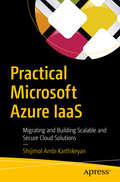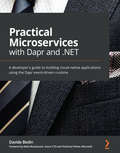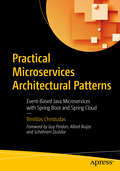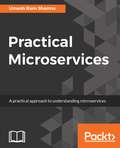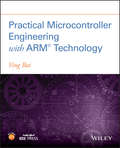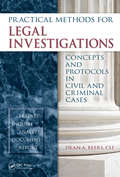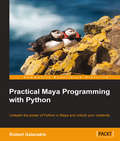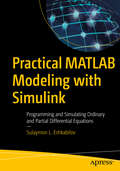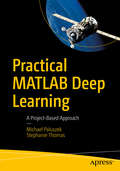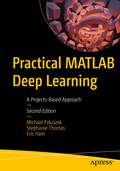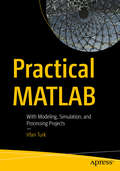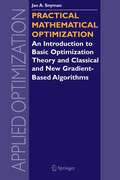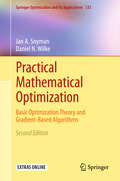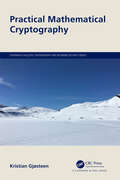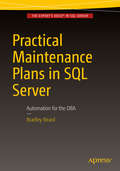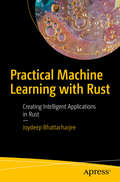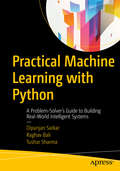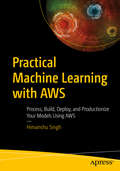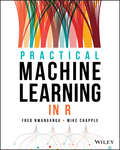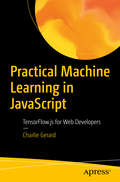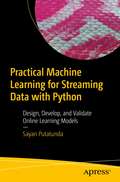- Table View
- List View
Practical Microsoft Azure IaaS: Migrating and Building Scalable and Secure Cloud Solutions
by Shijimol Ambi KarthikeyanAdopt Azure IaaS and migrate your on-premise infrastructure partially or fully to Azure. This book provides practical solutions by following Microsoft’s design and best practice guidelines for building highly available, scalable, and secure solution stacks using Microsoft Azure IaaS. The author starts by giving an overview of Azure IaaS and its components: you’ll see the new aspects of Azure Resource Manager, storage in IaaS, and Azure networking. As such, you’ll cover design considerations for migration and implementation of infrastructure services, giving you practical skills to apply to your own projects. The next part of the book takes you through the different components of Azure IaaS that need to be included in a resilient architecture and how to set up a highly available infrastructure in Azure. The author focuses on the tools available for Azure IaaS automated provisioning and the different performance monitoring and fine-tuning options available for the platform. Finally, you’ll gain practical skills in Azure security and implementing Azure architectures.After reading Practical Microsoft Azure IaaS, you will have learned how to map the familiar on-premise architecture components to their cloud infrastructure counterparts. This book provides a focused and practical approach to designing solutions to be hosted in Azure IaaS.What You Will LearnMap the key Azure components to familiar concepts in infrastructure, such as virtualization, storage provisioning, switching, and firewallsImplement Azure IaaS deployment architectures Design IaaS environments in line with the Microsoft recommended best practices for scalability, resiliency, availability, performance, and securityManage the operational aspects of hosted environments, leverage automation, and fine tune for optimal performanceWho This Book Is ForInfrastructure and solution architects with skills in on-premise infrastructure design who want to up-skill in Azure IaaS.
Practical Microservices with Dapr and .NET: A developer's guide to build cloud native applications using the Dapr event-driven runtime
by Mark Russinovich Davide BedinUse the new, enticing and highly portable event-driven runtime to simplify building resilient and scalable microservices for cloud and edge applications.Key FeaturesBuild resilient, stateless, and stateful microservice applications that run on the cloud and edgeSolve common distributed systems such as low latency and scaling using any language and frameworkUse real-time and proactive monitoring tools to support a reliable and highly available systemBook DescriptionOver the last decade, there has been a huge shift from heavily coded monolithic applications to finer, self-contained microservices. Dapr is a new, open source project by Microsoft that provides proven techniques and best practices for developing modern applications. It offers platform-agnostic features for running your applications on public cloud, on-premises, and even on edge devices.This book will help you get to grips with microservice architectures and how to manage application complexities with Dapr in no time. You'll understand how Dapr offers ease of implementation while allowing you to work with multiple languages and platforms. You'll also understand how Dapr's runtime, services, building blocks, and software development kits (SDKs) help you to simplify the creation of resilient and portable microservices. Dapr provides an event-driven runtime that supports the essential features you need to build microservices, including service invocation, state management, and publish/subscribe messaging. You'll explore all of those in addition to various other advanced features with this practical guide to learning Dapr.By the end of this book, you'll be able to write microservices easily using your choice of language or framework by implementing industry best practices to solve problems related to distributed systems.What you will learnUse Dapr to create services, invoking them directly and via pub/subDiscover best practices for working with microservice architecturesLeverage the actor model to orchestrate data and behaviorUse Azure Kubernetes Service to deploy a sample applicationMonitor Dapr applications using Zipkin, Prometheus, and GrafanaScale and load test Dapr applications on KubernetesWho this book is forThis book is for developers looking to explore microservices architectures and implement them in Dapr applications using examples on Microsoft .NET Core. Whether you are new to microservices or have knowledge of this architectural approach and want to get hands-on experience in using Dapr, you'll find this book useful. Familiarity with .NET Core will help you to understand the C# samples and code snippets used in the book.
Practical Microservices Architectural Patterns: Event-Based Java Microservices with Spring Boot and Spring Cloud
by Binildas ChristudasTake your distributed applications to the next level and see what the reference architectures associated with microservices can do for you. This book begins by showing you the distributed computing architecture landscape and provides an in-depth view of microservices architecture. Following this, you will work with CQRS, an essential pattern for microservices, and get a view of how distributed messaging works. Moving on, you will take a deep dive into Spring Boot and Spring Cloud. Coming back to CQRS, you will learn how event-driven microservices work with this pattern, using the Axon 2 framework. This takes you on to how transactions work with microservices followed by advanced architectures to address non-functional aspects such as high availability and scalability. In the concluding part of the book you develop your own enterprise-grade microservices application using the Axon framework and true BASE transactions, while making it as secure as possible.What You Will LearnShift from monolith architecture to microservices Work with distributed and ACID transactionsBuild solid architectures without two-phase commit transactionsDiscover the high availability principles in microservicesWho This Book Is ForJava developers with basic knowledge of distributed and multi-threaded application architecture, and no knowledge of Spring Boot or Spring Cloud. Knowledge of CQRS and event-driven architecture is not mandatory as this book will cover these in depth.
Practical Microservices
by Umesh Ram SharmaLearn how to implement the microservice architecture using Java About This Book • Leverage the power of microservices to build a flexible and efficient system in Java • See Docker and Spring Boot in practice to form easily deployable microservices • Hands-on approach throughout the book in order to familiarize and grasp the details Who This Book Is For This book is for Java developers who want to get started with microservices and implement it in their workplace. No knowledge of microservice is necessary. What You Will Learn • The role of a discovery service and externalized configuration in the overall architecture • Use of message brokers for event driven microservices • How to intermix data management strategies across components • Implementing different types of tests in Spring Boot environment • Applying CI to our microservices style architecture • Walk through of monitoring and scaling the sample application In Detail A microservice architecture helps you build your application as a suite of different services. This approach has been widely adopted as it helps to easily scale up your application with reduced dependencies. This way if a part of your application is corrupted, it can be fixed easily thereby eliminating the possibility of completely shutting down your software. This book will teach you how to leverage Java to build scalable microservices. You will learn the fundamentals of this architecture and how to efficiently implement it practically. We start off with a brief introduction to the microservice architecture and how it fares with the other architectures. The book dives deep into essential microservice components and how to set up seamless communication between two microservice end points. You will create an effective data model and learn different ways to test and deploy a microservices. You will also learn the best way to migrate your software from a monolith to a microservice architecture. Finishing off with monitoring, scaling and troubleshooting, this book will set a solid foundation for you to start implementing microservices. Style and approach Starting with the fundamentals, this book explains all the essential concepts gradually with the help of numerous examples.
Practical Microcontroller Engineering with ARM Technology
by Ying BaiThe first microcontroller textbook to provide complete and systemic introductions to all components and materials related to the ARM® Cortex®-M4 microcontroller system, including hardware and software as well as practical applications with real examples.This book covers both the fundamentals, as well as practical techniques in designing and building microcontrollers in industrial and commercial applications. Examples included in this book have been compiled, built, and tested Includes Both ARM® assembly and C codes Direct Register Access (DRA) model and the Software Driver (SD) model programming techniques and discussed If you are an instructor and adopted this book for your course, please email ieeeproposals@wiley.com to get access to the instructor files for this book.
Practical Microcontroller Engineering with ARM Technology
by Ying BaiThe first microcontroller textbook to provide complete and systemic introductions to all components and materials related to the ARM® Cortex®-M4 microcontroller system, including hardware and software as well as practical applications with real examples.This book covers both the fundamentals, as well as practical techniques in designing and building microcontrollers in industrial and commercial applications. Examples included in this book have been compiled, built, and tested Includes Both ARM® assembly and C codes Direct Register Access (DRA) model and the Software Driver (SD) model programming techniques and discussed If you are an instructor and adopted this book for your course, please email ieeeproposals@wiley.com to get access to the instructor files for this book.
Practical Methods for Legal Investigations: Concepts and Protocols in Civil and Criminal Cases
by CLI, Dean BeersLegal investigators are responsible for providing factual evidence � as the fact finders, they are the foundation for the attorneys they work with daily. The attorney is responsible for forming and implementing the legal strategy and presenting it to the judge or jury. The legal investigator provides checks and balances to ensure that no evidence i
Practical Maya Programming with Python
by Robert Galanakis"Practical Maya Programming with Python" is a practical tutorial packed with plenty of examples and sample projects which guides you through building reusable, independent modules and handling unexpected errors. If you are a developer looking to build a powerful system using Python and Maya's capabilities, then this book is for you. Practical Maya Programming with Python is perfect for intermediate users with basic experience in Python and Maya who want to better their knowledge and skills.
Practical MATLAB Modeling with Simulink: Programming and Simulating Ordinary and Partial Differential Equations
by Sulaymon L. EshkabilovEmploy the essential and hands-on tools and functions of MATLAB's ordinary differential equation (ODE) and partial differential equation (PDE) packages, which are explained and demonstrated via interactive examples and case studies. This book contains dozens of simulations and solved problems via m-files/scripts and Simulink models which help you to learn programming and modeling of more difficult, complex problems that involve the use of ODEs and PDEs.You’ll become efficient with many of the built-in tools and functions of MATLAB/Simulink while solving more complex engineering and scientific computing problems that require and use differential equations. Practical MATLAB Modeling with Simulink explains various practical issues of programming and modelling.After reading and using this book, you'll be proficient at using MATLAB and applying the source code from the book's examples as templates for your own projects in data science or engineering. What You Will LearnModel complex problems using MATLAB and SimulinkGain the programming and modeling essentials of MATLAB using ODEs and PDEsUse numerical methods to solve 1st and 2nd order ODEsSolve stiff, higher order, coupled, and implicit ODEsEmploy numerical methods to solve 1st and 2nd order linear PDEsSolve stiff, higher order, coupled, and implicit PDEsWho This Book Is ForEngineers, programmers, data scientists, and students majoring in engineering, applied/industrial math, data science, and scientific computing. This book continues where Apress' Beginning MATLAB and Simulink leaves off.
Practical MATLAB Deep Learning: A Project-Based Approach
by Michael Paluszek Stephanie ThomasHarness the power of MATLAB for deep-learning challenges. This book provides an introduction to deep learning and using MATLAB's deep-learning toolboxes. You’ll see how these toolboxes provide the complete set of functions needed to implement all aspects of deep learning. Along the way, you'll learn to model complex systems, including the stock market, natural language, and angles-only orbit determination. You’ll cover dynamics and control, and integrate deep-learning algorithms and approaches using MATLAB. You'll also apply deep learning to aircraft navigation using images. Finally, you'll carry out classification of ballet pirouettes using an inertial measurement unit to experiment with MATLAB's hardware capabilities. What You Will LearnExplore deep learning using MATLAB and compare it to algorithmsWrite a deep learning function in MATLAB and train it with examplesUse MATLAB toolboxes related to deep learningImplement tokamak disruption predictionWho This Book Is For Engineers, data scientists, and students wanting a book rich in examples on deep learning using MATLAB.
Practical MATLAB Deep Learning: A Projects-Based Approach
by Michael Paluszek Stephanie Thomas Eric HamHarness the power of MATLAB for deep-learning challenges. Practical MATLAB Deep Learning, Second Edition, remains a one-of a-kind book that provides an introduction to deep learning and using MATLAB's deep-learning toolboxes. In this book, you’ll see how these toolboxes provide the complete set of functions needed to implement all aspects of deep learning. This edition includes new and expanded projects, and covers generative deep learning and reinforcement learning. Over the course of the book, you'll learn to model complex systems and apply deep learning to problems in those areas. Applications include: Aircraft navigationAn aircraft that lands on Titan, the moon of Saturn, using reinforcement learningStock market predictionNatural language processingMusic creation usng generative deep learningPlasma controlEarth sensor processing for spacecraftMATLAB Bluetooth data acquisition applied to dance physics What You Will LearnExplore deep learning using MATLAB and compare it to algorithmsWrite a deep learning function in MATLAB and train it with examplesUse MATLAB toolboxes related to deep learningImplement tokamak disruption predictionNow includes reinforcement learningWho This Book Is For Engineers, data scientists, and students wanting a book rich in examples on deep learning using MATLAB.
Practical MATLAB: With Modeling, Simulation, and Processing Projects
by Irfan TurkApply MATLAB programming to the mathematical modeling of real-life problems from a wide range of topics. This pragmatic book shows you how to solve your programming problems, starting with a brief primer on MATLAB and the fundamentals of the MATLAB programming language. Then, you’ll build fully working examples and computational models found in the financial, engineering, and scientific sectors. As part of this section, you’ll cover signal and image processing, as well as GUIs. After reading and using Practical MATLAB and its accompanying source code, you’ll have the practical know-how and code to apply to your own MATLAB programming projects. What You Will LearnDiscover the fundamentals of MATLAB and how to get started with it for problem solvingApply MATLAB to a variety of problems and case studiesCarry out economic and financial modeling with MATLAB, including option pricing and compound interestUse MATLAB for simulation problems such as coin flips, dice rolling, random walks, and traffic flowsSolve computational biology problems with MATLABImplement signal processing with MATLAB, including currents, Fast Fourier Transforms (FFTs), and harmonic analysisProcess images with filters and edge detectionBuild applications with GUIs Who This Book Is ForPeople with some prior experience with programming and MATLAB.
Practical Mathematical Optimization: An Introduction to Basic Optimization Theory and Classical and New Gradient-Based Algorithms (Applied Optimization #97)
by Jan SnymanThis book presents basic optimization principles and gradient-based algorithms to a general audience, in a brief and easy-to-read form. It enables professionals to apply optimization theory to engineering, physics, chemistry, or business economics.
Practical Mathematical Optimization: Basic Optimization Theory and Gradient-Based Algorithms (Springer Optimization and Its Applications #133)
by Jan A Snyman Daniel N WilkeThis book presents basic optimization principles and gradient-based algorithms to a general audience, in a brief and easy-to-read form. It enables professionals to apply optimization theory to engineering, physics, chemistry, or business economics.
Practical Mathematical Cryptography (Chapman & Hall/CRC Cryptography and Network Security Series)
by Kristian GjøsteenPractical Mathematical Cryptography provides a clear and accessible introduction to practical mathematical cryptography. Cryptography, both as a science and as practice, lies at the intersection of mathematics and the science of computation, and the presentation emphasises the essential mathematical nature of the computations and arguments involved in cryptography. Cryptography is also a practical science, and the book shows how modern cryptography solves important practical problems in the real world, developing the theory and practice of cryptography from the basics to secure messaging and voting. The presentation provides a unified and consistent treatment of the most important cryptographic topics, from the initial design and analysis of basic cryptographic schemes towards applications. Features Builds from theory toward practical applications Suitable as the main text for a mathematical cryptography course Focus on secure messaging and voting systems.
Practical Mathematical Cryptography (Chapman & Hall/CRC Cryptography and Network Security Series)
by Kristian GjøsteenPractical Mathematical Cryptography provides a clear and accessible introduction to practical mathematical cryptography. Cryptography, both as a science and as practice, lies at the intersection of mathematics and the science of computation, and the presentation emphasises the essential mathematical nature of the computations and arguments involved in cryptography. Cryptography is also a practical science, and the book shows how modern cryptography solves important practical problems in the real world, developing the theory and practice of cryptography from the basics to secure messaging and voting. The presentation provides a unified and consistent treatment of the most important cryptographic topics, from the initial design and analysis of basic cryptographic schemes towards applications. Features Builds from theory toward practical applications Suitable as the main text for a mathematical cryptography course Focus on secure messaging and voting systems.
Practical Maintenance Plans in SQL Server: Automation for the DBA
by Bradley BeardThis book is a complete guide to setting up and maintaining maintenance plans for SQL Server Database Administrators. Maintenance plans too often consist of a backup task and that’s it, but there is so much more that can and must be done to ensure the integrity of your most important company resource – the data you are tasked to manage and safeguard. This book walks even the newest of users through creating a powerful, automated maintenance plan. Automate your job using SQL Server Agent to leverage the power of Maintenance Plans to deliver real, proactive solutions to common issues. Schedule common tasks such as backups and index rebuilds to run automatically, and get early-warning notifications of impending problems relating to resource usage and query performance. By the time your boss knows to call you about a problem, you’ll have already called him to describe your solution. The large majority of books never really cover the topic of inheriting a database server with multiple live databases; the common thread is that the databases will be created and maintained by the reader forever and ever. In the real world, that scenario rarely happens. Practical Maintenance Plans in SQL Server covers that scenario and provides you with the knowledge and tools needed to get comfortable writing your own maintenance plans for any SQL Server database, whether created by you or inherited. Shows the different tasks that can be run in a maintenance plan.Explains how and why those tasks can be implemented.Provides a roadmap to creating your own custom maintenance plan.What You Will LearnImplement a completely automated backup maintenance planBe alerted to performance problems and outages ahead of your bossLearn the different types of database maintenance tasksPlan the workflow of tasks within a maintenance planAutomate your work by implementing custom maintenance plansWho This Book Is ForPractical Maintenance Plans in SQL Server is for any level of database administrator, but specifically it’s for those administrators with a real need to set up a powerful maintenance plan quickly. New and seasoned administrators will appreciate the book for its robust learning pattern of visual aids in combination with explanations and scenarios. Practical Maintenance Plans in SQL Server is the perfect “new hire” gift for new database administrators in any organization.
Practical Machine Learning with Rust: Creating Intelligent Applications in Rust
by Joydeep BhattacharjeeExplore machine learning in Rust and learn about the intricacies of creating machine learning applications. This book begins by covering the important concepts of machine learning such as supervised, unsupervised, and reinforcement learning, and the basics of Rust. Further, you’ll dive into the more specific fields of machine learning, such as computer vision and natural language processing, and look at the Rust libraries that help create applications for those domains. We will also look at how to deploy these applications either on site or over the cloud. After reading Practical Machine Learning with Rust, you will have a solid understanding of creating high computation libraries using Rust. Armed with the knowledge of this amazing language, you will be able to create applications that are more performant, memory safe, and less resource heavy. What You Will LearnWrite machine learning algorithms in RustUse Rust libraries for different tasks in machine learningCreate concise Rust packages for your machine learning applicationsImplement NLP and computer vision in RustDeploy your code in the cloud and on bare metal servers Who This Book Is For Machine learning engineers and software engineers interested in building machine learning applications in Rust.
Practical Machine Learning with Python: A Problem-Solver's Guide to Building Real-World Intelligent Systems
by Dipanjan Sarkar Raghav Bali Tushar SharmaMaster the essential skills needed to recognize and solve complex problems with machine learning and deep learning. Using real-world examples that leverage the popular Python machine learning ecosystem, this book is your perfect companion for learning the art and science of machine learning to become a successful practitioner. The concepts, techniques, tools, frameworks, and methodologies used in this book will teach you how to think, design, build, and execute machine learning systems and projects successfully.Practical Machine Learning with Python follows a structured and comprehensive three-tiered approach packed with hands-on examples and code. Part 1 focuses on understanding machine learning concepts and tools. This includes machine learning basics with a broad overview of algorithms, techniques, concepts and applications, followed by a tour of the entire Python machine learning ecosystem. Brief guides for useful machine learning tools, libraries and frameworks are also covered. Part 2 details standard machine learning pipelines, with an emphasis on data processing analysis, feature engineering, and modeling. You will learn how to process, wrangle, summarize and visualize data in its various forms. Feature engineering and selection methodologies will be covered in detail with real-world datasets followed by model building, tuning, interpretation and deployment. Part 3 explores multiple real-world case studies spanning diverse domains and industries like retail, transportation, movies, music, marketing, computer vision and finance. For each case study, you will learn the application of various machine learning techniques and methods. The hands-on examples will help you become familiar with state-of-the-art machine learning tools and techniques and understand what algorithms are best suited for any problem. Practical Machine Learning with Python will empower you to start solving your own problems with machine learning today!What You'll LearnExecute end-to-end machine learning projects and systemsImplement hands-on examples with industry standard, open source, robust machine learning tools and frameworksReview case studies depicting applications of machine learning and deep learning on diverse domains and industriesApply a wide range of machine learning models including regression, classification, and clustering.Understand and apply the latest models and methodologies from deep learning including CNNs, RNNs, LSTMs and transfer learning. Who This Book Is ForIT professionals, analysts, developers, data scientists, engineers, graduate students
Practical Machine Learning with AWS: Process, Build, Deploy, and Productionize Your Models Using AWS
by Himanshu SinghSuccessfully build, tune, deploy, and productionize any machine learning model, and know how to automate the process from data processing to deployment. This book is divided into three parts. Part I introduces basic cloud concepts and terminologies related to AWS services such as S3, EC2, Identity Access Management, Roles, Load Balancer, and Cloud Formation. It also covers cloud security topics such as AWS Compliance and artifacts, and the AWS Shield and CloudWatch monitoring service built for developers and DevOps engineers. Part II covers machine learning in AWS using SageMaker, which gives developers and data scientists the ability to build, train, and deploy machine learning models. Part III explores other AWS services such as Amazon Comprehend (a natural language processing service that uses machine learning to find insights and relationships in text), Amazon Forecast (helps you deliver accurate forecasts), and Amazon Textract.By the end of the book, you will understand the machine learning pipeline and how to execute any machine learning model using AWS. The book will also help you prepare for the AWS Certified Machine Learning—Specialty certification exam.What You Will LearnBe familiar with the different machine learning services offered by AWS Understand S3, EC2, Identity Access Management, and Cloud FormationUnderstand SageMaker, Amazon Comprehend, and Amazon ForecastExecute live projects: from the pre-processing phase to deployment on AWSWho This Book Is ForMachine learning engineers who want to learn AWS machine learning services, and acquire an AWS machine learning specialty certification
Practical Machine Learning on Databricks: Seamlessly transition ML models and MLOps on Databricks
by Debu SinhaTake your machine learning skills to the next level by mastering databricks and building robust ML pipeline solutions for future ML innovationsKey FeaturesLearn to build robust ML pipeline solutions for databricks transitionMaster commonly available features like AutoML and MLflowLeverage data governance and model deployment using MLflow model registryPurchase of the print or Kindle book includes a free PDF eBookBook DescriptionUnleash the potential of databricks for end-to-end machine learning with this comprehensive guide, tailored for experienced data scientists and developers transitioning from DIY or other cloud platforms. Building on a strong foundation in Python, Practical Machine Learning on Databricks serves as your roadmap from development to production, covering all intermediary steps using the databricks platform. You’ll start with an overview of machine learning applications, databricks platform features, and MLflow. Next, you’ll dive into data preparation, model selection, and training essentials and discover the power of databricks feature store for precomputing feature tables. You’ll also learn to kickstart your projects using databricks AutoML and automate retraining and deployment through databricks workflows. By the end of this book, you’ll have mastered MLflow for experiment tracking, collaboration, and advanced use cases like model interpretability and governance. The book is enriched with hands-on example code at every step. While primarily focused on generally available features, the book equips you to easily adapt to future innovations in machine learning, databricks, and MLflow.What you will learnTransition smoothly from DIY setups to databricksMaster AutoML for quick ML experiment setupAutomate model retraining and deploymentLeverage databricks feature store for data prepUse MLflow for effective experiment trackingGain practical insights for scalable ML solutionsFind out how to handle model drifts in production environmentsWho this book is forThis book is for experienced data scientists, engineers, and developers proficient in Python, statistics, and ML lifecycle looking to transition to databricks from DIY clouds. Introductory Spark knowledge is a must to make the most out of this book, however, end-to-end ML workflows will be covered. If you aim to accelerate your machine learning workflows and deploy scalable, robust solutions, this book is an indispensable resource.
Practical Machine Learning in R
by Fred Nwanganga Mike ChappleGuides professionals and students through the rapidly growing field of machine learning with hands-on examples in the popular R programming language Machine learning—a branch of Artificial Intelligence (AI) which enables computers to improve their results and learn new approaches without explicit instructions—allows organizations to reveal patterns in their data and incorporate predictive analytics into their decision-making process. Practical Machine Learning in R provides a hands-on approach to solving business problems with intelligent, self-learning computer algorithms. Bestselling author and data analytics experts Fred Nwanganga and Mike Chapple explain what machine learning is, demonstrate its organizational benefits, and provide hands-on examples created in the R programming language. A perfect guide for professional self-taught learners or students in an introductory machine learning course, this reader-friendly book illustrates the numerous real-world business uses of machine learning approaches. Clear and detailed chapters cover data wrangling, R programming with the popular RStudio tool, classification and regression techniques, performance evaluation, and more. Explores data management techniques, including data collection, exploration and dimensionality reduction Covers unsupervised learning, where readers identify and summarize patterns using approaches such as apriori, eclat and clustering Describes the principles behind the Nearest Neighbor, Decision Tree and Naive Bayes classification techniques Explains how to evaluate and choose the right model, as well as how to improve model performance using ensemble methods such as Random Forest and XGBoost Practical Machine Learning in R is a must-have guide for business analysts, data scientists, and other professionals interested in leveraging the power of AI to solve business problems, as well as students and independent learners seeking to enter the field.
Practical Machine Learning in R
by Fred Nwanganga Mike ChappleGuides professionals and students through the rapidly growing field of machine learning with hands-on examples in the popular R programming language Machine learning—a branch of Artificial Intelligence (AI) which enables computers to improve their results and learn new approaches without explicit instructions—allows organizations to reveal patterns in their data and incorporate predictive analytics into their decision-making process. Practical Machine Learning in R provides a hands-on approach to solving business problems with intelligent, self-learning computer algorithms. Bestselling author and data analytics experts Fred Nwanganga and Mike Chapple explain what machine learning is, demonstrate its organizational benefits, and provide hands-on examples created in the R programming language. A perfect guide for professional self-taught learners or students in an introductory machine learning course, this reader-friendly book illustrates the numerous real-world business uses of machine learning approaches. Clear and detailed chapters cover data wrangling, R programming with the popular RStudio tool, classification and regression techniques, performance evaluation, and more. Explores data management techniques, including data collection, exploration and dimensionality reduction Covers unsupervised learning, where readers identify and summarize patterns using approaches such as apriori, eclat and clustering Describes the principles behind the Nearest Neighbor, Decision Tree and Naive Bayes classification techniques Explains how to evaluate and choose the right model, as well as how to improve model performance using ensemble methods such as Random Forest and XGBoost Practical Machine Learning in R is a must-have guide for business analysts, data scientists, and other professionals interested in leveraging the power of AI to solve business problems, as well as students and independent learners seeking to enter the field.
Practical Machine Learning in JavaScript: TensorFlow.js for Web Developers
by Charlie GerardBuild machine learning web applications without having to learn a new language. This book will help you develop basic knowledge of machine learning concepts and applications. You’ll learn not only theory, but also dive into code samples and example projects with TensorFlow.js. Using these skills and your knowledge as a web developer, you’ll add a whole new field of development to your tool set. This will give you a more concrete understanding of the possibilities offered by machine learning. Discover how ML will impact the future of not just programming in general, but web development specifically. Machine learning is currently one of the most exciting technology fields with the potential to impact industries from health to home automation to retail, and even art. Google has now introduced TensorFlow.js—an iteration of TensorFlow aimed directly at web developers. Practical Machine Learning in JavaScript will help you stay relevant in the tech industry with new tools, trends, and best practices.What You'll LearnUse the JavaScript framework for MLBuild machine learning applications for the webDevelop dynamic and intelligent web contentWho This Book Is ForWeb developers and who want a hands-on introduction to machine learning in JavaScript. A working knowledge of the JavaScript language is recommended.
Practical Machine Learning for Streaming Data with Python: Design, Develop, and Validate Online Learning Models
by Sayan PutatundaDesign, develop, and validate machine learning models with streaming data using the Scikit-Multiflow framework. This book is a quick start guide for data scientists and machine learning engineers looking to implement machine learning models for streaming data with Python to generate real-time insights. You'll start with an introduction to streaming data, the various challenges associated with it, some of its real-world business applications, and various windowing techniques. You'll then examine incremental and online learning algorithms, and the concept of model evaluation with streaming data and get introduced to the Scikit-Multiflow framework in Python. This is followed by a review of the various change detection/concept drift detection algorithms and the implementation of various datasets using Scikit-Multiflow.Introduction to the various supervised and unsupervised algorithms for streaming data, and their implementation on various datasets using Python are also covered. The book concludes by briefly covering other open-source tools available for streaming data such as Spark, MOA (Massive Online Analysis), Kafka, and more.What You'll LearnUnderstand machine learning with streaming data conceptsReview incremental and online learningDevelop models for detecting concept driftExplore techniques for classification, regression, and ensemble learning in streaming data contextsApply best practices for debugging and validating machine learning models in streaming data contextGet introduced to other open-source frameworks for handling streaming data.Who This Book Is ForMachine learning engineers and data science professionals
